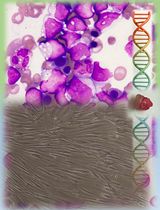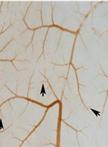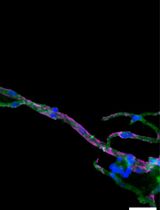- EN - English
- CN - 中文
Chick Neural Tube Explant Culture
鸡胚胎神经管外植体培养
发布: 2015年10月05日第5卷第19期 DOI: 10.21769/BioProtoc.1608 浏览次数: 11004
评审: Oneil G. BhalalaPamela MaherGeoff Lau

相关实验方案

髓系肿瘤中用于生殖系 DNA 分离的皮肤成纤维细胞标准化培养:一种从床旁到实验室的实用方法
Parampreet Kour [...] Pulkit Rastogi
2025年10月05日 1357 阅读
Abstract
The neural tube explant culture technique allows in vitro culturing of small pieces of neural tissue isolated from e.g., chick or mouse embryonic tissue in a matrix of collagen for defined periods of time. This method can be used to study the effects of defined molecules on developmental processes such as neural progenitor proliferation and neuronal differentiation and/or survival. Since the explant material can also be prepared from embryonic tissue electroporated with expression vectors, this technique can be adapted to study gene function in the presence of specific environmental signals. Different regions of the neural tube can also be isolated during the dissection step, allowing specific regions of the neural tube to be studied separately. Here, we present a neural tube explant culture method that we have used in several studies (Dias et al., 2014; Lek et al., 2010; Vallstedt et al., 2005).
Materials and Reagents
- 10 cm Petri dish (SARSTEDT AG & Co, catalog number: 82.1473 )
- Glass Pasteur pipette 150 mm (VWR International, catalog number: 612-1701 )
- Transfer pipette (SARSTEDT AG & Co, catalog number: 86.1174 )
- Tungsten wire (Goodfellow, catalog number: w005160 )
- 10 ml syringe (HARTMANN USA, Omnifix®, catalog number: 4617100V )
- Needle 20 G (Henke Sass Wolf, catalog number: 4710009040 )
- Fresh fertilized chick eggs (ideally from a local supplier)
- L-15 medium (Life Technologies, catalog number: 11415-049 )
Note: Currently, it is “Thermo Fisher Scientific, GibcoTM, catalog number: 11415-049”. - Dispase I (Roche Diagnostics, catalog number: 04942086001 )
- Heat inactivated Fetal bovine serum (FBS) ( Life Technologies, GibcoTM, catalog number: 10106-169 )
Note: Currently, it is “Thermo Fisher Scientific, Gibco™, catalog number: 10106-169 ”. - Dulbecco’s modified eagle’s medium 10x (MEM) (Sigma-Aldrich, catalog number: D2429 )
- Sodium hydroxide (NaOH) (EMD Millipore Corporation, catalog number: 1.06469.1000 )
- Collagen (3.1 mg/ml) (Pure Col) (Advanced BioMatrix, catalog number: 5005-B )
- Sodium bicarbonate 7.5% (BIC) (Life Technologies, catalog number: 25080 )
Note: Currently, it is “Thermo Fisher Scientific, GibcoTM, catalog number: 25080”. - DMEM/F-12, GlutaMAXTM supplement (Life Technologies, catalog number: 31331-028 )
Note: Currently, it is “Thermo Fisher Scientific, GibcoTM, catalog number: 31331-028”. - Neurobasal medium (Life Technologies, catalog number: 21103-049 )
Note: Currently, it is “Thermo Fisher Scientific, GibcoTM, catalog number: 21103-049”. - Albumin from bovine serum (BSA) (Sigma-Aldrich, catalog number: A7906 )
- Glutamax (Life Technologies, catalog number: 35050-038 )
Note: Currently, it is “Thermo Fisher Scientific, GibcoTM, catalog number: 35050-038”. - Penicillin Streptomycin (PEST) (Life Technologies, catalog number: 15140-122 )
Note: Currently, it is “Thermo Fisher Scientific, GibcoTM, catalog number: 15140-122”. - N2-supplement (Life Technologies, catalog number: 17502-048 )
Note: Currently, it is “Thermo Fisher Scientific, GibcoTM, catalog number: 17502-048”. - B27-supplement (Life Technologies, catalog number: 17504-044 )
Note: Currently, it is “Thermo Fisher Scientific, GibcoTM, catalog number: 17504-044”. - 2-mercaptoethanol (Sigma-Aldrich, catalog number: M3148 )
- Dispase I solution (see Recipes)
- Bedding solution (see Recipes)
- Growing media (see Recipes)
Equipment
- Humidified, 38 °C egg incubator (Grumbach, catalog number: 8012 )
- Humidified, 37 °C tissue culture incubator (Thermo Fisher Scientific, catalog number: 51030287 )
- 16 °C incubator (Gemini BV Laboratory,Liebherr, catalog number: 4294 F1-1 )
- Dissection microscope and light source (ZEISS, models: Zeiss Stemi SV11 and Zeiss KL1500LCD )
- Borosilicate glass capillaries (Harvard Apparatus, catalog number: GC100TF-10 )
- Nunc 4-well dishes for IVF (Thermo Fisher Scientific, catalog number: 144444 )
- Flaming/brown micropipette puller (SUTTER, catalog number: P-97 )
- Needle holder (Fine science tools, catalog number: 26016-12 )
- Tweezers (Fine science tools, catalog number: 11252-20 )
- Micro-scissors (Fine science tools, catalog number: 15000-00 )
- Dissection scissors (Fine science tools, catalog number: 14088-10 )
- Mouth aspirator system/Aspirator tube assemblies for calibrated microcapillary pipettes (Sigma-Aldrich, catalog number: A5177-5EA )
Procedure
文章信息
版权信息
© 2015 The Authors; exclusive licensee Bio-protocol LLC.
如何引用
Alekseenko, Z., Andersson, E. and Dias, J. M. (2015). Chick Neural Tube Explant Culture. Bio-protocol 5(19): e1608. DOI: 10.21769/BioProtoc.1608.
分类
神经科学 > 发育 > 外植体培养
细胞生物学 > 组织分析 > 组织分离
您对这篇实验方法有问题吗?
在此处发布您的问题,我们将邀请本文作者来回答。同时,我们会将您的问题发布到Bio-protocol Exchange,以便寻求社区成员的帮助。
Share
Bluesky
X
Copy link










